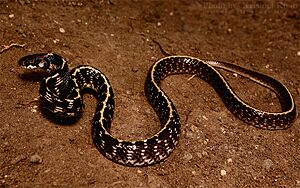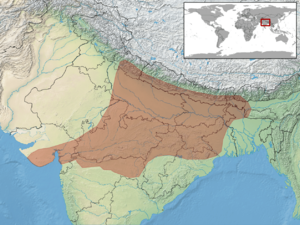Indian egg-eating snake facts for kids
Quick facts for kids Indian egg-eating snake |
|
|---|---|
 |
|
| Indian egg-eater at Amravati | |
| Conservation status | |
| Scientific classification | |
| Genus: |
Elachistodon
|
| Species: |
westermanni
|
 |
|
| Synonyms | |
|
|
The Indian egg-eating snake or Indian egg-eater (Elachistodon westermanni) is a rare species of snake. It belongs to the Colubridae family. This snake is special because it only eats eggs. It is found only in the Indian subcontinent. People also call it Westermann's snake. This name comes from its scientific name. It is the only species in its group, called Elachistodon.
Contents
About the Name
The second part of the snake's scientific name, westermanni, honors a Dutch zoologist. His name was Geraldus Frederick Westermann. He lived from 1807 to 1890.
Where It Lives
The Indian egg-eating snake is found in several countries. These include Bangladesh, India, and Nepal. Recently, people have found this snake in many parts of India. These areas include Maharashtra, Gujarat, Punjab, Madhya Pradesh, Telangana, and Karnataka.
Its Home Environment
This snake prefers to live in natural places like forests and shrubland. It can be found at different heights above sea level. These heights range from about 40 meters (130 feet) to 1,000 meters (3,280 feet).
What It Looks Like
The Indian egg-eating snake has a shiny look. Its body color can be brown to black. It has bluish-white spots near its tail. A creamy stripe runs down its back from its neck to the tip of its tail. The snake's head is brown. It has a black arrow-shaped mark on it. Its belly is white with small brown dots. Adult snakes can grow up to 78 centimeters (31 inches) long. Their tail can be about 11 centimeters (4.25 inches) long.
How It Behaves
This snake can be active during the day or night. It lives on the ground. However, it is very good at climbing plants and trees. When it feels threatened, it has a special defense. It lifts the front part of its body. Then it forms S-shaped coils. This helps it try to scare away danger.
What It Eats
The Indian egg-eating snake eats only bird eggs. It chooses eggs that have not yet started to grow a baby bird. This snake has amazing body parts that help it eat eggs. It has special bones in its neck, called vertebral hypapophyses. These bones stick out into its throat. They are covered with a hard, enamel-like material. These bones help to crack the eggs as the snake swallows them. The only other snakes that eat eggs this way are from Africa. They belong to a group called Dasypeltis.
Reproduction
The Indian egg-eating snake reproduces by laying eggs. This means it is an oviparous species.
Images for kids



